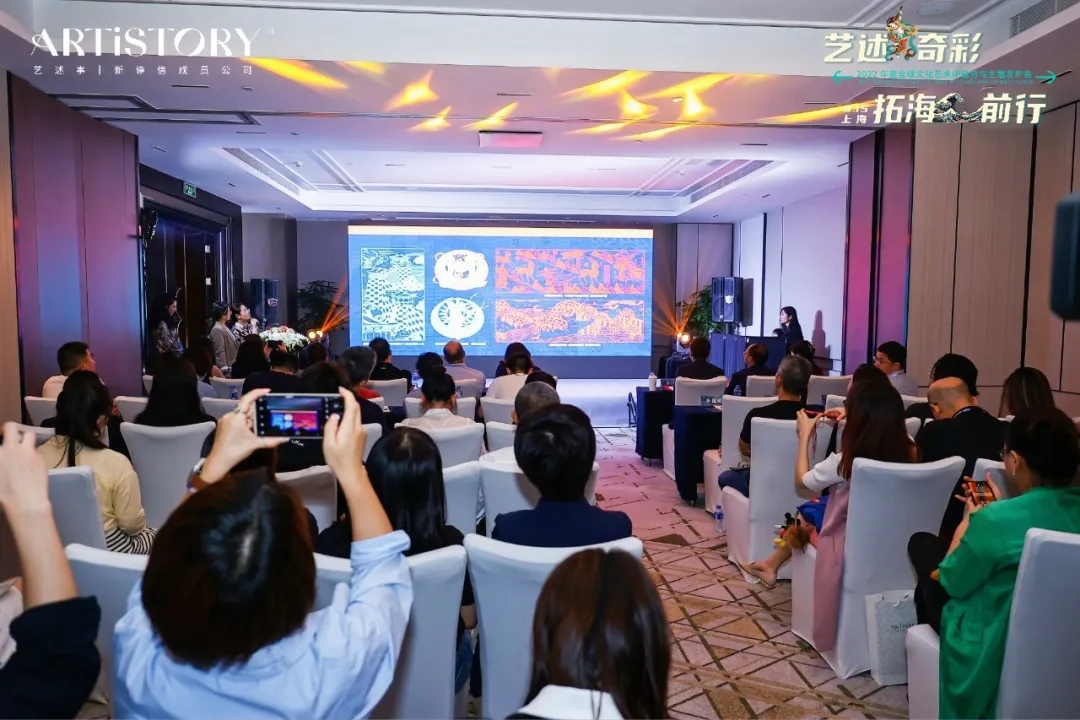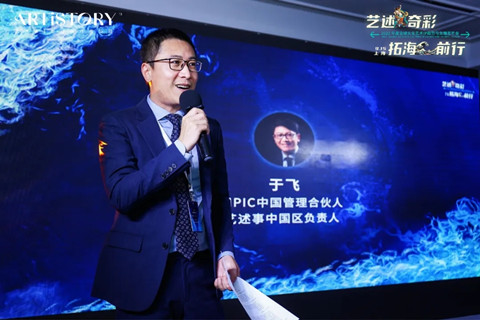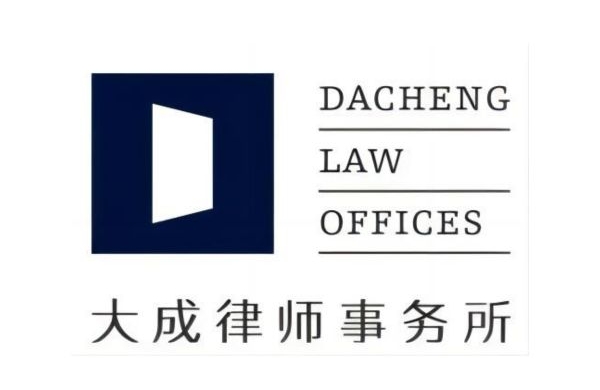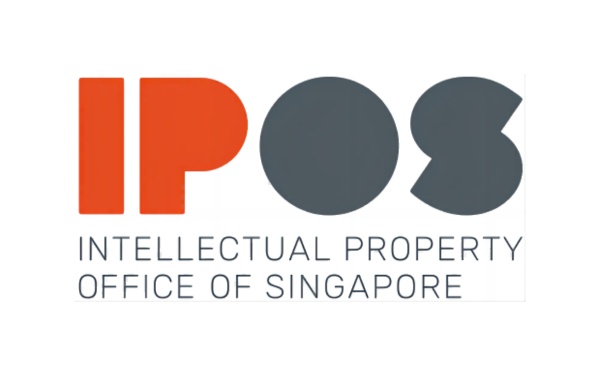Did not receive verification mail? Please confirm whether the mailbox is correct or not Re send mail

IPR Daily
- 2021-12-08 16:02:49
Interview | Building a Unique Top-level IP Licensing Matrix

On September 15th, 2021, ARTISTORY China held the "2022 Global Arts and Cultural IP Trends and Themes Launch” in Shanghai.
For the first time, ARTISTORY announced its world's top arts and cultural IP licensors, four annual arts and cultural IP themes, and global IP licensing business.
At the launch, ARTISTORY also revealed officially the collaboration with Dunhuang Inspiration. This is the first time for both domestic and international arts and cultural IP to jointly be released under creatively developed themes for the global markets.

2022 Global Arts and Cultural IP Trends and Themes launch

Mr. Yu Fei, the managing partner of Sinofaith IP Investment Co., Ltd. (SIPIC) and head of ARTISTORY China
About Yu Fei
Recently, IPR Daily invited Mr. Yu Fei, a managing partner of Sinofaith IP Investment Co., Ltd. (SIPIC) and head of ARTISTORY China, to discuss in depth the arts and cultural IP licensing, and answer questions about the investment and use of arts and cultural IP rights. It is reported that SIPIC is affiliated to Sinofaith IP Group, and is an investment fund that specializes in investing in arts and cultural IP licensing and related fields domesticaly and abroad. As a member of Sinofaith IP Group, ARTISTORY plays a key role in Sinofaith's IP chain.

ARTISTORY 2022's four themes of arts and cultural IP

Showcase of the licensing authorization letter to ARTISTORY from the world's top arts and cultural IP
PART ONE
IPR Daily :
Sinofaith is a household name in the intellectual property industry, but ARTISTORY is a relatively new company to the intellectual property industry.
May I ask Mr. Yu Fei,
what kind of company is ARTISTORY?
What kind of coincidence did Sinofaith decide to establish it?
Why did Sinofaith decide to join the cultural IP industry?
Does it mean that cultural IP is becoming more and more important?
Yu Fei :
When we analyzed the licensing industry as a whole 5 or 6 years ago, we found that art and non-profit organizations usually only accounted for a small percentage of the sales of licensed products.
Generally, art and non-profit organizations can only account for 1.5% of the global licensing market. Today, according to data from the International Licensing Industry Association, art and non-profit organization licensing has shown explosive growth, with its market share increasing from 1.5% to 17%, making it the second largest revenue contribution category after entertainment IP. Sinofaith is fortunate to witness this tremendous growth as an investor.
The value of arts and cultural IP licensing is obvious in the retail field and the added value of authorized brands. Many Chinese companies, especially DTC brands, can attract consumers, increase brand premiums, and give product connotations through the combination of arts and cultural IP.
In addition, we are beginning to see more and more Chinese brands starting to go overseas and entering the global market. At this time, Chinese brands can attract consumers in overseas markets through arts and cultural IP.
Not only that, Chinese brands have also presented new needs and responsibilities in the selection of arts and cultural IP when going abroad. Consumers in overseas markets need to have a process of cognition of Chinese brands, but they are familiar with arts and cultural content.
At this time, arts and cultural IP can help Chinese companies eliminate the brand strangeness of overseas consumers and implant their brands into the minds of overseas consumers.
At the same time, many companies and brands have begun to take social responsibility into consideration.
The dissemination of culture and art itself is a manifestation of corporate social responsibility, and it also contributes to the cause of Chinese culture going abroad, which is in line with the national strategic direction.
IPR Daily :
May I ask Mr. Yu Fei, how does Sinofaith obtain long-term, exclusive license rights from cultural IP copyright owners such as museums at home and abroad?
Why develop the annual theme and design assets? From SIPIC to ARTISTORY, to authorized merchants at home and abroad, how is this licensing chain arranged?
Please introduce in detail the specific work done by ARTISTORY in the cultural IP licensing proces.
Yu Fei :
Sinofaith has established two investment funds in Shanghai and Singapore respectively, forming professional teams in the fields of development, operation, licensing and investment, focusing on investing in the right to operate the top IPs in global culture, art, science, books and other fields in key global areas.
As the IP side, the museums are looking forward to close, long-term partners who can add value to their IP operations, rather than loose, temporary partners who consume IP value in the short term.
In addition, years of experience in the intellectual property right confirmation and protection system and leading service model of Sinofaith are also valued by cultural IP parties at home and abroad.
The reason why Sinofaith clearly proposes and pragmatically invests in the development of the annual theme and design assets is because the top IP integrated by the fund has a wealth of collections and contents, and these collections and contents are precious treasure in the history of human civilization and culture. However, the collections and contents that have not been scientifically transformed are still cultural collections.
There is still a huge gap between collections and commodities, including the cultural connotation of the collection, the story narrative of the theme, the trendy style of ornamentation, and the extraction of icon, prediction and matching of trends, etc.
For authorized merchants, it is obviously not enough to provide them with the content and the logo of the museum at the time of licensing, and it can only satisfy a very small number of authorized merchants with marketing positioning and development capabilities.
In the context of the upgrading of China's overall cultural consumption industry, what the licensing market needs most are top IPs, trendy and continuous annual themes, and easy-to-apply design assets. It comes from classics and gives it new life. It is precisely the reason for the activation of collections and the empathy for more young consumers. Only what everyone loves will be paid attention to, and the accessibility of museums and museum collections can be truly improved.
In addition, the development of the annual theme and design assets will generate secondary creations, thereby generating new intellectual property rights, so Sinofaith can assist the IP side in better and more scientific protection of the results and the market.
Through the unique advantages mentioned above, Sinofaith integrates the operating rights of top IPs in the fields of global culture, art, science, books, etc.; and through the IP Asset Center based on professional institution data support and scientific professional trend analysis, the collections and content are sorted and researched, multi-level annual themes are determined, and design assets development and transformation are completed to form IP assets and development results that meet the market needs.
ARTISTORY, as a global annual arts and cultural IP theme and trendsetter and a market-oriented licensing specialist, integrates, researches, analyzes, and develops IP assets produced by the IP asset center through the offices in China, the United States, the United Kingdom, Spain, Singapore, Japan and other places authorize the majority of authorized merchants around the world.
At the same time, brands and companies are empowered through narratives, together with industry leaders based on IP assets to develop arts and cultural content matrix to increase attention, combined with IP assets to plan and implement exhibitions, and help brands and companies complete event and event marketing.
The team members are composed of experts in the cultural and art industry and global intellectual property professionals, which also makes us firmly believe that this unique top-level IP licensing matrix will succeed.
PART TWO
IPR daily :
What are the unique advantages of ARTISTORY's business model?
How can this model be used as a reference for other companies in the intellectual property industry?
Yu Fei :
ARTISTORY's own business model is truly operating IP, from theme development to design assets, from intellectual property right confirmation to intellectual property protection, from IP right holders to IP authorized parties, makes both parties feel at ease to the greatest extent. Licensed business is not only a manifestation of commercial value, but also a manifestation of the social responsibility of cultural communication. Culture and art are no longer enjoyed by a few people, but through practical actions such as annual theme, design gallery, marketing planning, narrative empowerment, etc., while IP empowers enterprises and products, to make more people being able to enjoy the beauty brought by culture and art is a real win-win for realizing the business value and social value of the enterprise.
Sinofaith will also feed public cultural undertakings, help museums to carry out cultural dissemination, art promotion, science popularization, etc.
ARTISTORY will not be an IP agency, but a publisher of arts and cultural trends and themes in key markets around the world and a value-adder of IP.
In addition, ARTISTORY, based on its global offices and professional team, and its advantages owning global/multi-regional full-category IP operating rights, can break the authorized regional barriers and help brands and enterprises achieve IP linkages in marketing, sales, products, and events on a global scale.
PART THREE
IPR Daily :
How does ARTISTORY promote top Chinese cultural IP like Dunhuang to the domestic and overseas markets?
How many countries does ARTISTORY’s cultural copyright licensing business have covered?
What is the situation of domestic business development? While developing its business, what challenges does ARTISTORY face both abroad and domestically?
How will ARTISTORY deal with these challenges?
Yu Fei :
Dunhuang is a testimony of the integration of civilizations on the Silk Road, and has its influence all over the world, just as there are a wide range of fans of ancient Chinese culture and art all over the world.
ARTISTORY will follow the development context of global trend themes, gather Dunhuang’s all-encompassing cultural ICON, develop Dunhuang exclusive trend themes and design assets that conform to the market’s aesthetics, based on ARTiSTORY’s global team, unite global brands and enterprises to bring Dunhuang and more top Chinese cultural IPs to the global market. At present, the copyright licensing business has covered China, North America, Europe, the Middle East, Southeast Asia, Africa and other licensing regions, and has offices in Shanghai, Beijing, Tokyo, Singapore, the United Kingdom, Spain, New York and other cities.
The domestic licensing business has been carried out in an orderly manner. Due to the special business model of ARTISTORY, it has attracted many global brands and enterprises to cooperate.
Because the ARTISTORY team is scattered in many countries and cities around the world, the main challenge at present is the problem of jet lag.
However, today when Chinese companies go overseas, we are facing many problems, which are also problems faced by many of our customers. We will manage through data management system, remote conference, multi-threaded task collaboration, localized collaboration to solve this problem.
As far as the licensing business is concerned, the main problem is that it is difficult for the design assets development team to meet the increasingly diversified market needs.
But this problem has a good solution. ARTISTORY has launched the Living Artist program. On the premise of ensuring the dissemination of the cultural core, such problems can be solved with expressions that can be understood by multiple markets, and at the same time, a new model of the museum's IP X artist X brand has been created in the field of licensing.
I believe that brands and companies will like this new model very much, which also solves the problem of the diversity of style needs in the global market.

Dunhuang cultural and creative products originally developed by ARTISTORY
PART FOUR
IPR Daily :
With the global development of ARTISTORY and the expansion of business volume, have you encountered any infringements in its business operations? How did you deal with it?
Yu Fei :
The issue of infringement is actually a normalized issue. The solution is to do a good job in confirming the rights, and the right confirmation sector has always been one of the areas covered by the Sinofaith Group. On the one hand, we help IP parties complete the trademark registration and territorial extension work in the relevant authorized market areas, and prevent related IP trademarks from being registered; on the other hand, the secondary development of the design assets can regenerate copyrights, thereby laying the foundation for protection actions. Of course, even if the relevant rights are confirmed, infringements are inevitable. At this time, Sinofaith will launch online and physical market monitoring projects to monitor infringements. Once discovered, effective countermeasures against infringements will be implemented, including but not limited to notifications and warnings, civil, administrative and even criminal actions.
Since ARTISTORY's licensing activities are carried out globally, we will also rely on the global intellectual property protection cooperation system built by Sinofaith Group over the years to escort licensing activities and the legitimate rights and interests of authorized parties.
PART FIVE
IPR Daily :
How can ARTISTORY better balance the social public interest, commerciality and artistry of cultural IP products in the operation of arts and cultural IP?
Is the higher the artistic quality of cultural products, the higher the commerciality of IP? How does ARTISTORY specifically evaluate the commercial value of a certain cultural product?
Yu Fei :
The arts and cultural IP operation that ARTISTORY is engaged in is actually the activation of cultural IP, and the promotion of museums is itself a business with social responsibility and public interest.
The collections in the museums not only include cultural and artistic attributes, but also have historical materials and other attributes. It is not appropriate to judge the level of commerciality simply by the level of artistry. A collection, whether it is related to culture, art or technology, the core reason why we choose it is whether it can empathize with consumers.
Emotion is always the scarce luxury, and the most touching is the most valuable. What the public needs is emotional sustenance and freshness, and the name of ARTISTORY reflects our judgment standards.
A cultural product that can tell a good story and can make people empathize has commercial value. The more people that can resonate, the greater its commercial value.
Our goal is to help companies use culture and art to tell product stories, so that the public and consumers can empathize with them.
PART SIX
IPR Daily :
Business is never wishful thinking, so does ARTISTORY have cooperation standards for authorized parties?
What efforts have you made to prevent cultural IP licensed products from falling into Universalization?
Yu Fei :
Universalization, I understand it is a matter of homogeneity or convergence.
ARTISTORY has established a complete set of authorized project evaluation system and authorized product review system, based on the premise of respecting the core of culture and art, and avoiding products that are too entertaining, too general, and too simplistic.
Because this kind of behavior itself is a kind of damage to IP, we hope that every licensing behavior is a value-added to IP, so that more audiences can join the cultural and artistic world, so as to realize the popularization of culture and art to the general public.
Preventing cultural IP licensed products from falling into generalization or uniformity is the core of ensuring IP commercial value and the foundation of sustainable development. The trend themes and design assets proposed by Sinofaith and ARTISTORY are to avoid this situation.
A museum has millions of collections, spans the entire history of human civilization, and covers almost every moment when the stars of mankind shine. It can be said to be an inexhaustible treasure of IP.
The IP Asset Center will continue to sort out and explore content based on different levels of trending themes and collections, and then give authorized merchants the most suitable, novel, and most touching works and stories. I believe this will be a flourishing situation.
PART SEVEN
IPR Daily :
With which copyright parties has Sinofaith reached cooperation?
Yu Fei :
At present, we have signed global licensing cooperation agreements (except China) with the Boston Museum of Fine Arts, the National Gallery of Britain, and the National Palace Museum in Taipei, and signed global exclusive licensing cooperation agreements with Dunhuang Inspiration and the Brooklyn Museum.
In addition, we are negotiating for cooperation with more than 10 top museum parties, including culture, art, technology, books and other fields.
It is believed that Sinofaith will integrate more arts and cultural IP globally and invest in the licensing market.
PART EIGHT
IPR Daily :
From your long-term experience, what is the difference between the cooperation model with foreign museums and the cooperation model with Chinese local museums?
Yu Fei :
Because overseas museums have been engaged in the licensing business for quite a long time, they will have a clearer understanding of the procedures and details of licensing, and they are more inclined to choose a partner for long-term cooperation. Domestic museums are more inclined to choose multiple subjects for cooperation, but this kind of cooperation will cause everyone to not make efforts for the appreciation of IP, and it is easy to make some short-term goals.
However, with the adjustment of related policies, domestic museums are changing their concepts, and at the same time they are also expanding their horizons to overseas.
It is their responsibility to spread culture overseas. I believe that with Sinofaith's unremitting efforts and achievements, there will be more and more domestic museums choose to cooperate with Sinofaith and ARTISTORY to make museum IP more valuable.
As domestic museums take on more social and cultural dissemination responsibilities and considerations, ARTISTORY will give more consideration to the social principles of public cultural dissemination in cooperation with domestic museums, and treat collections with a more rigorous and serious attitude and scientific and professional development process. Reasonably develop and use with caution.
PART NINE
IPR Daily :
Foreign cultural IP protection is very advanced. We talked about the issue of cultural innovation. In the long-term cooperation with foreign countries, what do you think we can learn from foreign operations?
Yu Fei :
Actually, the issue of intellectual property is a stage of social development.
With the development of China’s intellectual property strategy, China’s intellectual property environment has been greatly improved.
The importance that foreign cultural IP owners attach to their own intellectual property rights and their experience in the IP development review process can inspire domestic cultural innovation.
IP licensing is not only a commercial act, but also a legal act, and also a compliance act. All parties in the industry chain cooperate in good faith, operate in compliance, and work together to do a good job with social responsibility and public value.
This is the authorized business should be done. Cultural innovation is not only innovation, it is also a boost to assist China in completing industrial upgrading, and Chinese brands go overseas, Chinese culture goes overseas, Chinese cultural innovation is not only the responsibility of one party, it is the common cause of practitioners in all links of the entire industrial chain.
The direction of the effort is based on the need for everyone to uphold their beliefs, let the IP appreciate, let the work appreciate, and let the labor appreciate.
PART TEN
IPR Daily :
In addition to cooperation with museums, what major actions will ARTISTORY have next?
Yu Fei :
Next, in addition to cooperating with museums, we plan to collaborate with artists to launch: the Living Artist project, which allows artists and museum IP to produce new works together, so that new works will have a new chemical reaction with brands and businesses. This is an exciting plan.
In addition, we also plan to launch a series of immersive projects, art showcases, urban activities, and digital projects, which may be NFT or meta-universe projects. This depends on which partners can work together to empower the museum's IP in various forms. So that more audiences can enjoy the emotional resonance brought by the museum IP.
PART ELEVEN
IPR Daily :
What do you think of the current situation in the field of cultural IP licensing?
What are the problems with it?
In response to these issues, do you have any specific suggestions?
What efforts will ARTISTORY make to solve these problems?
Yu Fei :
The field of cultural IP licensing is thriving. Many practitioners in the industry have very good ideas and practices.
This is what we are happy to see.
However, there is indeed the problem of over-entertainment and the licensing rights management system is not good enough.
Licensing management lies in compliance, and the issue of scale lies in the understanding of cultural and artistic connotations and the establishment of the museum’s review system.
In general, it is necessary to establish a scientific licensing system. Sinofaith and ARTISTORY will establish an licensing management system from multiple dimensions such as rights confirmation, licensing, and rights protection, and work together with museum owners and industry practitioners to make the entire licensing industry healthier.
According to statistics, China has more than 5,300 museums, 767,000 immovable cultural relics, more than 100 million state-owned movable cultural relics, and a large number of private cultural relics.
How to better protect artistic treasures and maximize the social value of cultural heritage is an important content of cultural heritage work in the new era.
Cultural IP licensing is a combination of art and commerce. This model allows seemingly stereotyped cultural relics to "speak" and reach the public, giving them new vitality and value. However, the current domestic cultural IP licensing has many problems in terms of intellectual property rights, creative development, and talent training.
We expect that more "ARTISTORY" will join the industry to open up more directions for the development of cultural dissemination.
Source: IPRdaily (iprdaily.cn)
Reporter: Li Meng, Wang Ying
Editor: IPRdaily-Rene
- I also said the two sentence
- Also you can enter 140words
 PurpleVine Successfully Assists Client in Invalidating Sisvel US Patent
PurpleVine Successfully Assists Client in Invalidating Sisvel US Patent Chang Tsi & Partners Successfully Represents Wuxi's First Intellectual Property Civil Case Attached to Criminal Case
Chang Tsi & Partners Successfully Represents Wuxi's First Intellectual Property Civil Case Attached to Criminal Case China Monthly Antitrust Update: February 2024
China Monthly Antitrust Update: February 2024 IPOS was publishing a legal decision involving the trademark of tech giant, Google
IPOS was publishing a legal decision involving the trademark of tech giant, Google


